Yeast Attenuation Calculator: Formula & Fermentation Phases
Understanding the yeast attenuation calculator can be both simple and complex as it relates to the fermentation phases. First, you have to accept that yeast is a living organism and will not operate on a precise clock. Second, you will learn through experimentation how to read your fermentation process and understand the output of a given formula based on which yeast and beer style you are working with.
Reading your fermentation phases will help you perfect your brewing craft.
Utilizing the yeast attenuation calculator will help you understand attenuation rates of various yeasts as they relate to the various ingredients with which you experiment.

What Is Yeast Attenuation?
Yeast attenuation refers to the rate at which yeast converts sugars to alcohol and carbon dioxide – basically how long fermentation takes.
When considering this time period, it is critical to remember that each strain of yeast operates on its own unique schedule and each type of beer will take its own time.
In general, however, we can say most brewer’s yeasts are going to fall under two categories – ale, or Saccharomyces cerevisiae, and lager, or Saccharomyces pastorianus.
Within these two categories, we also have specialty beers that stem from wine yeasts and kveik yeasts, both of which are still S. cerevisiae strains, but which can tolerate higher alcohol levels and ferment at higher temperatures.
We also know that ale yeast tends to ferment at warmer temperatures and more quickly, while lager yeast tends to ferment at cooler temperatures and more slowly.
The Brewer’s Role in Fermentation
While the attenuation calendar is not really under the control of the brewer but rather under his supervision, there are a few things for which the brewer is responsible that can ensure a smooth fermentation.
First, the choice of yeast is paramount.
Understanding which strain of yeast you want to use, why, and then how to work with it at a basic level is key to success in brewing.
Next, your choice of grain will lend a great deal to your attenuation rate. Knowing that malted barley has much more sugar than ungerminated wheat, for example, will help you understand why attenuation is going more quickly or more slowly.
Temperature is the third element under the brewer’s control. Pay close attention to which strain of yeast you are working with and what the proper temperature range is for that yeast.
Finally, oxygen levels can make or break a fermentation. Your yeast cells absolutely need oxygen when they are first getting started and then should have absolutely no oxygen once active fermentation has begun. This balance can be tricky and must be perfected in order to avoid the off flavors that can come from wort that has been oxidized during fermentation.
Lag Phase
The first phase of Fermentation on your attenuation calendar is the lag phase. This phase is the time period between when you pitch your yeast into your wort and when you can see active fermentation.
For kveik yeasts, this lag phase can be as short as 30 minutes.
For ale and wine yeasts, it usually takes about 24 hours.
For lager yeasts, it often takes all the way up to 48 hours.
Remember that just because you don’t see activity does not mean nothing is happening.
Especially if you pitched dry yeast, it takes time for the yeast to be activated, to wake up, and to adjust to its surroundings before it starts actively fermenting your wort.
Active Phase
The active phase, then, is what happens once yeast gets to fermenting.
This phase can last anywhere from 4 to 8 days, and it is here that you will see all the bubbling, frothing, krausening, and more.
The yeast is busy consuming all of your fermentable sugars and converting them to alcohol and carbon dioxide.
You will know when you are at the end of the active phase when your krausen, or the foamy crust on your beer, has died down and the yeast is beginning to clump either on the surface for ale yeast or on the bottom of your vessel for lager yeast.
You can take a gravity reading to be sure. Once your gravity reading has remained the same for a couple of days, you know your active phase is at an end.
You can then plug your gravity readings into a formula to understand what your yeast attenuation rate is.
The Yeast Attenuation Calculator Formula

To make this yeast attenuation calculation, you are simply calculating the difference between the solids at the start of the fermentation and the solids during and after fermentation.
The solids are the fermentable sugars, which are heavier than water. We call this “heaviness” measurable gravity.
As the yeast consumes the sugars and converts them to alcohol and carbon dioxide, the gravity reading will decline.
Thus, yeast attenuation is a reflection of how much the wort concentration – the heaviness – has been reduced, or how much the gravity has changed.
We use ADF to refer to the attenuation rate, or apparent attenuation.
To plug your gravity readings into a formula and get an apparent attenuation rate, you would use the following:
ADF = 100% x (Starting Gravity – Current Gravity) / (Starting Gravity – 1)
So, for a beer with a starting gravity of 1.050 and a current gravity of 1.010, your calculation would look like this:
100% x (1.050 – 1.010) / (1.050 – 1) = 80%
Thus, your attenuation rate for that particular strain of yeast in that brew is 80%.
Stationary Phase
The stationary phase is the last phase on your attenuation calendar, and it can take a day or several months.
It is during this phase that your yeast cells will slow down and begin to do the work of “mopping up” all the diacetyl still in your beer, cleaning up all off flavors, and smoothing out aroma and texture.
It is really up to the brewer how long you would like to age your beer. You could perform a secondary racking and allow beer to settle on the remaining yeast cells for a few months to have a nice smooth beer, or you could rack for only a week or two to simply ensure all of your off flavors are wrapped up.
This last phase is the most experimental of all, and will depend largely on the yeast, the brew, and of course, the brewer.
Just remember to have fun while playing with your attenuation calendar. It is, after all, a craft.
Cheers!
Are you still pitching fresh yeast every time? By reusing your yeast, you can save up to hundreds of thousands of dollars per year on just yeast alone!
Join the hundreds of brewers from all around the world using the Smartest Automated Yeast Cell Counter! Request a Free Demo Account today and experience firsthand how Oculyze can take your brewery to the next level!
Sources:
- https://www.asianbeernetwork.com/stages-of-beer-fermentation-fermentation-timeline/
- https://winning-homebrew.com/beer-attenuation.html#:~:text=Apparent%20Attenuation%20(or%20ADF)%20%3D,(Starting%20Gravity%20%E2%80%93%201).&text=Real%20Extract%20will%20be%20the,of%20alcohol%20in%20the%20wort
Stay on top on important fermentation insights – subscribe to our monthly newsletter and receive a hand-picked selection of our most relevant articles straight to your inbox.
Never miss a beat and get real time updates with a new article each workday by subscribing our social media channels.
Instagram | Facebook | Twitter | YouTube


